
 |
|
#1
|
|||
|
|||
|
I present to you this important IC in the field of remote sensing, which is characterized by selectivity in detection, as you can specify the central frequency you want to search for, and it will detect that signal for you if it is present in the field. While rejecting other unwanted signals. Despite its simple appearance, the circuit is complex and consists of more than 62 transistors.
For full information and how to use, see the data sheet. With a note, it is used in detecting radio frequencies, light, infrared, sound, and radar modifications. It depends on the added sensor circuit. Note: You must study the data sheet well to be able to use it and work correctly. https://www.homemade-circuits.com/lm...-features-and/ 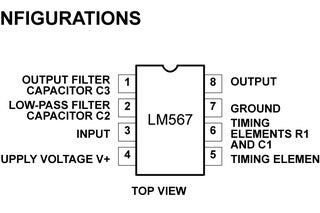 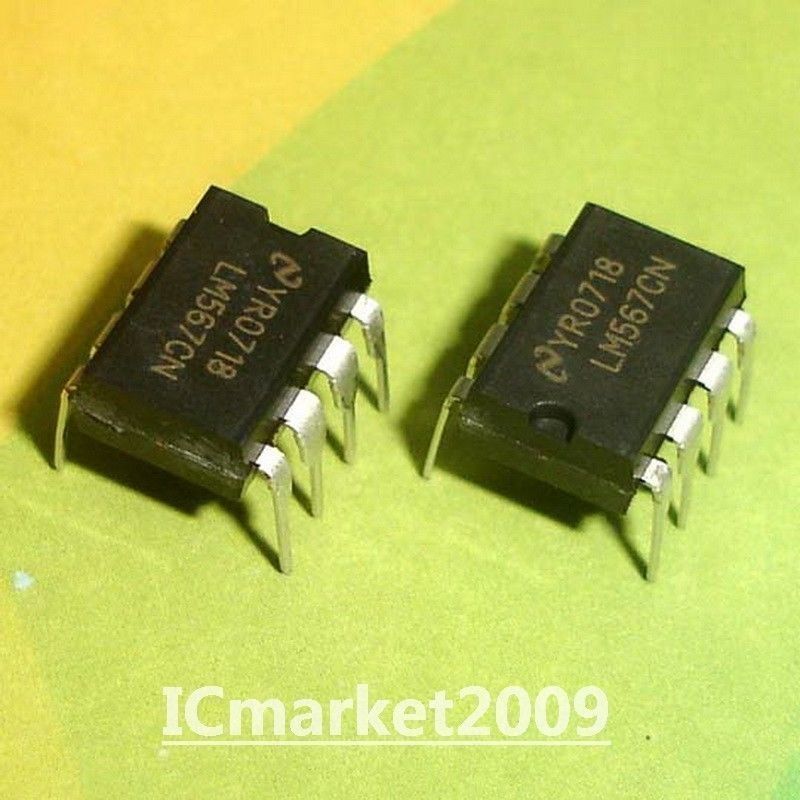
|
|
#2
|
|||
|
|||
|
Quote:
|
|
#3
|
|||
|
|||
|
Hello my friend Bahoum, and thank you for this nice intervention.
the resonance frequency in nature was calculated, it was found that the frequency of the basic metal of gold is 37 Hz and that of the silver metal is 87 Hz. These values vary according to the strength of the earth?s field in your area. We try to help in this area as much as possible while keeping things simple. The question that arises and which many disagree about is what type of signal we are looking for. * Chapter One: If the signal is electrical, and this is what I am convinced of, it resembles a spark, a cigarette lighter, or lightning in the form of pulses with very small amplitudes that can be detected using germanium or Schottky detector diodes with a demodulation feature and extracting the low frequency of the pulse. * Chapter Two: There are those who claim the ability of infrared rays to detect. If we use sunlight as an infrared transmitter and monitor its reflection from the Earth's surface and the magnitude of the pulsation, this may be a good solution in determining the center. $$ My important question that needs to be answered is if a radio frequency is directed at a metal surface, is it reflected with a modified imprint of the metal or is it reflected without modification? Thanks |
|
#4
|
|||
|
|||
|
Quote:
|
|
#5
|
|||
|
|||
|
|
|
#6
|
|||
|
|||
|
* When the radio frequency is reflected from the surface of the metal, it will carry with it the resonance of the metal, They create an amplitude and phase jump at each resonant frequency of the returned signal which is a technique used in radar.
* The resonance signal for metals is an electrical signal in the megahertz and gigahertz range. * Gold responds well to radio frequencies because of its high conductivity and does not corrode like other metals in the soil. The high density of gold makes it interact greatly with radio frequencies and has a significant effect on the radio frequencies reflected from its surface. It reflects the radio signal well * Metal detector radar uses radio frequencies to penetrate the ground to accurately detect metals. The best medium frequency range. This range is balanced with penetrating power and accuracy. * Schottkine diodes are better than germanium for detecting weak electrical signals. ( Pin diodes) are specialized in very small capacitances and are used when high-sensitivity detection characteristics are needed. * Photoelectric technology uses light to detect metal resonances by measuring changes in light $ The source of this information is artificial intelligence |
|
#7
|
|||
|
|||
|
Quote:
this description is very interesting and I think very accurate! |
|
#8
|
||||
|
||||
|
Many years ago (maybe 20) i constructed an electronic dowsing rod using the LM567.I found the schematic

__________________
Geo |
|
#9
|
|||
|
|||
|
Hello friends,
relying on the ringing of natural metal for detection, I think is not enough. It may be suitable for large sizes only. Due to the presence of influential external factors that control the strength of the corona and change the values, such as your proximity and distance from the Earth?s magnetic poles, the movement of the Moon around the Earth and its effect on the strength of the Earth?s magnetic field and climate, heat gives the electrons kinetic energy and makes them active and spread over the Earth?s surface because they are mostly concentrated on the Earth?s surface, so the air is a natural insulator for them. $ The Earth?s conductivity affects the transmission of the beam to the Earth?s surface. Several haloes may form for the object, and they may deviate from the center of the target a lot. External radio frequencies are also effective. Large mineral masses (mineral rocks) have an effect. Therefore, there will be no stability for the aura with its frequency values, activity, and location. Luck will play a big role in success. When you are at the right time and the right place. $ This information is based on my personal follow-ups. I archive it here in the forum for others to benefit. I think my friend Geography added a better sensor circuit. Illustrative image only. 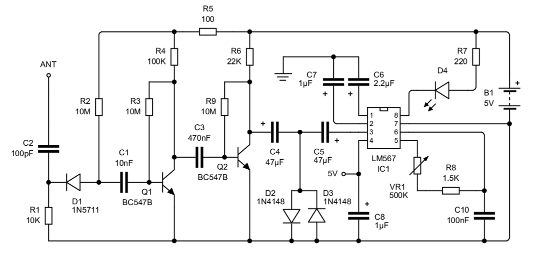
|
|
#10
|
|||
|
|||
|
Quote:
You have made this schematic? I think with an additional circuit it will be a very good general receiver. |
|
#11
|
|||
|
|||
|
Hello friend Kostas 87.
Don't forget, this type of circuit has become more selective with the LM567. We left out randomness. The detection range is approximately (19 Hz to 6 kHz) . I will put together an infrared sensor circuit to illustrate the idea of the variety that can be achieved while maintaining selectivity. With a bandwidth between approximately ( 1% - 25% ) . ] Note: The diagrams that I design have not been confirmed to work with the 567 because the simulation program I use does not contain the 567, so we recommend trying the circuit on a breadboard first. 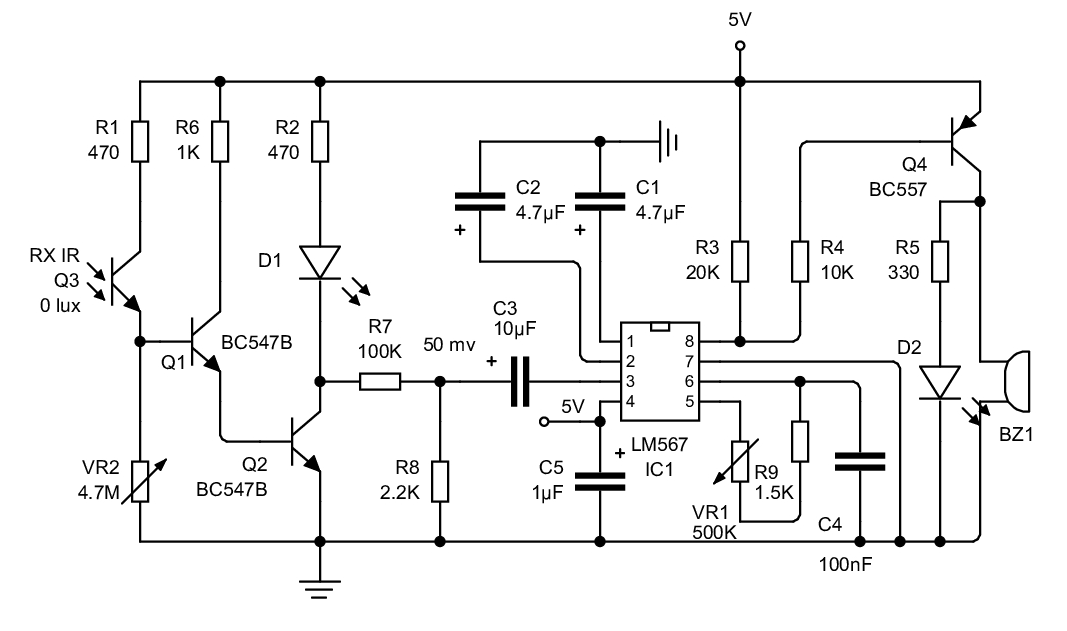
|
|
#12
|
|||
|
|||
|
Quote:
Hi Omar Personally i had made an IR receiver trying to demodulate any possible useful frequency that might be imposed on it. I tried for demodulating frequencies in the KHz range (strong signals) that exist in the area but the result was very dissapointing. The IR field behaved like it is a total dc field with not any short of fluctuations. Despite the high amplification stage i never got any response. I think that you should include in your research the diamagnetic property of the target. |
|
#13
|
|||
|
|||
|
I don't know
But if the resonance effect is a capacitive effect, the signal will not appear with high frequencies of infrared radiation. It will be lost within the carrier signal, so it is suitable for measurement only based on the intensity of reflection . ( Capacitive modulation is used for intermediate frequencies (AM)) . This may be an explanation that they prefer to use 250 kHz receiving resonance circuits in long-range metal detectors. Coincidentally, this frequency is also used to detect electrical signals. Magnetism cannot be relied upon to detect precious metals because they are non-magnetic metals. Most suitable for ferrous metals. 
|
|
#14
|
|||
|
|||
|
Quote:
Diamagnetic material means that opposes to any magnetic field change. So it also induces currents but in a direction so to oppose the incident magnetic field change. It is like the transformer effect. So magnetism and diamagnetism are the two mirror sides of the same coin. 
|
|
#15
|
|||
|
|||
|
|
|
#16
|
|||
|
|||
|
|
|
#17
|
|||
|
|||
|
I have been experimenting on a lm567 breadboard. ...and I found the following:
$ is also affected and detects multiples of the center frequency with less sensitivity, so the detection range must be narrowed, especially with the square wave. $ It works well with frequencies of kHz, and the higher the frequency, the greater the detection accuracy and reliability. $ It faces problems and difficulties with very low frequencies Hz in terms of reliability and detection accuracy. $ It needs a different approach in design to accurately detect very low frequencies. $ The high noise of the supply voltage stops it from working. $ Using a high variable resistor, such as 470K, to switch the center frequency is not suitable for this chip. $ The input signal voltage is less than 20 mV and it will stop working. $ The input signal voltage is higher than 200 mV, the bandwidth increases and the accuracy decreases .$ The use of large capacity capacitors for the output capacitor C3 is desirable when detecting very low frequencies to increase the delay and get rid of unwanted signals $ Connecting capacitors to connections close to the chip to reduce noise. |
|
#18
|
|||
|
|||
|
($) - Sensor section..... Wide-spectrum sensor starting from 150 khz up to approximately 3 Ghz . The source of the idea is the link below.
https://techlib.com/electronics/allband.htm 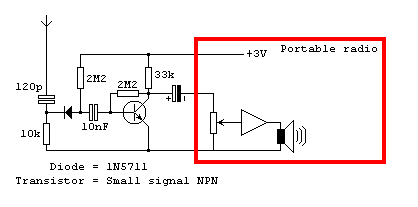 ($$) - Relay section (synchronization, amplification, and signal cleaning)... to detect very low frequencies. Designed by Engineer John, link to the source page. https://www.qsl.net/kd2bd/vor.html 
|
|
#19
|
|||
|
|||
|
Hello...
I have been conducting experiments on a signal processor, and here I thank engineer John for this wonderful circuit that he made available to the public for general use. The initial results were very important as follows.... $ - First paragraph It has now become possible to detect very low frequencies with high accuracy and reliability. The triangle wave was tried. Things were excellent and there were no problems with detection.... $ - The second paragraph.... The problems started with the sine and square waves. We found that knowing the main frequency is not enough to detect it... There is something called the pulse width, spacing, or pulse time, which is A type of primary frequency coding... (For example) to detect a 37 Hz sine wave that cannot be detected by relying only on this fundamental frequency, the pulse width must be known to calculate the coding frequency to detect that signal. In normal mode (the main frequency divided by two is the encoding frequency) to detect the main frequency (37/2 = 18.5 Hz)... As an example, this means when dealing with a sine or square signal, the detector must be set to the encoding frequency, which is 18.5 Hz, to detect the fundamental frequency. 37 Hz outdoors.... In nature, the matter is similar. If the electrical signal is sinusoidal, the frequency and pulse width or spacing must be known to calculate the coding frequency of the signal to be detected. Note that the type of circuit filters controls the frequency pulse width. To overcome this dilemma, an appropriate detection range must be chosen. It contains the fundamental frequency and the coding frequency. |
|
#20
|
|||
|
|||
|
Well done Omar! And an article describing the work. Although there is no data in the article that for normal operation of the Filter at low frequencies on the LM 567, the incoming signal must be at least 20 mV. and in some cases more. Then the microcircuit works correctly in the low frequency range.
|
|
#21
|
|||
|
|||
|
Quote:
you are right |
|
#22
|
|||
|
|||
|
Good morning Omar! From the post you wrote, you propose an Active Search System with its own target irradiation transmitter. And if I misunderstood the translation, do you have a positive result in air or is this just a theory?
|
|
#23
|
|||
|
|||
|
Hello Bahoum... Yes, something that looks like a radar. But it's still a theory
|
|
#24
|
|||
|
|||
|
Quote:
|
|
#25
|
|||
|
|||
|
Hello Bahoum....
It seems that it is very difficult for amateurs and even advanced people. Dealing with radio frequencies and radio resonance circuits, adjusting, stabilizing and powering them, is not easy. The capacitive change, if any, will be slight, and sorting it out from all this noise seems impossible. I don't know, there may be a simpler solution. What do you think? Give us an idea or theory . |
 |
|
|